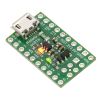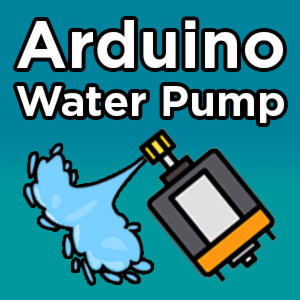A-Star 32U4 Micro
Available with a lead time
Expect dispatch between Jan 06 and Jan 09
Quantity Discounts:
- 10+ $31.15 (exc GST)
- 25+ $30.18 (exc GST)
 |
|
A-Star 32U4 Micro, bottom view with U.S. quarter for size reference. |
|---|
The Pololu A-Star 32U4 Micro is a general-purpose programmable module based on the ATmega32U4 AVR microcontroller from Microchip (formerly Atmel), which has 32 KB of flash program memory, 2.5 KB of RAM, and built-in USB functionality. Onboard features of the A-Star (abbreviated A*) include a 16 MHz resonator, a USB Micro-B connector, an in-system programming (ISP) header, and a pair of indicator LEDs. A voltage regulator and power selection circuit allow the board to be powered from either USB or an external 5.5 V to 15 V source, while a resettable PTC fuse on the USB VBUS supply and reverse protection on VIN help protect it from accidental damage.
The A-Star 32U4 Micro breaks out 15 general-purpose I/O lines along two rows of pins, including 7 usable as PWM outputs and 8 usable as analog inputs; another three GPIO pins can be accessed through the 6-pin ISP header. It fits all this into a 20-pin dual in-line package (DIP) measuring only 1" × 0.6" (even smaller than competing ATmega32U4 boards like the Teensy 2.0 and Pro Micro), and its 0.1" pin spacing makes the A* easy to use with solderless breadboards, perfboards, and 0.1"-pitch connectors.
Pololu's comprehensive user’s guide provides the basics you need to get started with the A-Star as well as detailed technical information for advanced users.
This product requires a USB A to Micro-B cable (not included) to connect to a computer.
Features
- Dimensions: 1" × 0.6" (1.05" × 0.6" including USB Micro-B connector)
- Programmable 16 MHz ATmega32U4 AVR microcontroller
- 32 KB flash (4 KB used by bootloader, leaving 28 KB available for user program by default)
- 2.5 KB SRAM
- 1 KB EEPROM
- Native full-speed USB (12 Mbps)
- Preloaded with Arduino-compatible bootloader (no external programmer required)
- Many I/O lines in a small package
- 15 general-purpose I/O pins available along the sides of the board
- 3 additional I/O pins available on ISP header
- 7 pins can be configured as hardware PWM outputs
- 8 pins can be configured as analog inputs
- 2 user-controllable LEDs
- Can be powered from USB or external 5.5 V to 15 V source on VIN
- PTC fuse on VBUS supply
- Reverse-voltage protection on VIN supply
- 6-pin ISP header for use with an external programmer
- Comprehensive user’s guide
Arduino compatibility
The A-Star 32U4 ships with a preloaded Arduino-compatible bootloader (which uses 4 KB of flash memory, leaving 28 KB available for the user program). Pololu provide a software add-on that enables the board to be easily programmed from the Arduino environment.
The A-Star 32U4 uses the same microcontroller as the Arduino Leonardo and Arduino Micro and runs at the same frequency, making it just as powerful. Although the larger boards offer a few more I/O pins, the A-Star 32U4 Micro fits in an area half that of the Arduino Micro, and it takes up only 11% as much area as a standard full-size Arduino!
 |
|
Pololu A-Star 32U4 Micro, Pololu A-Star 32U4 Mini SV, Arduino Micro, and Arduino Leonardo. |
|---|
Pinout
 |
This diagram identifies the I/O and power pins on the A-Star 32U4 Micro; it is also available as a printable PDF (409k pdf). For more information about the ATmega32U4 microcontroller on this board, see Microchip’s ATmega32U4 documentation.
Printed on the A* circuit board are indicators that you can use to quickly identify each pin’s capabilities: a triangle next to the pin means it can be used as an analog input, and a square wave symbol under the pin number means it can be used as a PWM output.
The board can either be powered directly from the USB 5 V supply or from a separate 5.5 V to 15 V source on the VIN pin, which is reduced to 5 V by a 100 mA low-dropout (LDO) regulator; you can access this 5 V supply through the 5V power output pin. Additionally, the ATmega32U4 contains an internal 3.3 V regulator whose output is available on the 3V3 pin. Current drawn from the 3V3 output should not exceed about 50 mA, and when the board is being powered through VIN, the sum of the 5V output current, 3V3 output current, GPIO output current, and current used by the board itself (typically about 25 mA) should not exceed 100 mA.
Included hardware
A 1×20-pin breakaway 0.1" male header is included with the A-Star 32U4 Micro, which can be soldered in to use the board with perfboards, breadboards, or 0.1" female connectors. (The headers might ship already separated into two 1×10 pieces.) Also included is a 2×3 header that can be installed to allow external programming of the microcontroller through the AVR ISP interface, such as with Pololu's USB AVR programmer.
|
|
The A-Star family
 |
|
From top to bottom: A-Star 328PB Micro, 32U4 Micro, 32U4 Mini SV, and 32U4 Prime SV. |
|---|
The A-Star 32U4 Micro is a part of Pololu's larger A-Star family, all of whose members are based on AVR microcontrollers and are preloaded with Arduino-compatible bootloaders. The table below shows some key features and specifications of Pololu's A-Star microcontroller boards to help you choose the right one for your application.
 |
 |
   |
  |
  |
|
|---|---|---|---|---|---|
| A-Star 328PB Micro | A-Star 32U4 Micro | A-Star 32U4 Mini ULV A-Star 32U4 Mini LV A-Star 32U4 Mini SV |
A-Star 32U4 Prime LV A-Star 32U4 Prime SV |
A-Star 32U4 Robot Controller LV A-Star 32U4 Robot Controller SV |
|
| Microcontroller: | ATmega328PB | ATmega32U4 | |||
| User I/O lines: | 24 | 18 | 26 | 26(1) | 26(1) |
| PWM outputs: | 9 | 7 | 7 | 7 | 7(1) |
| Analog inputs: | 8 | 8 | 12 | 12 | 12(1) |
| Ground access points: | 6 | 2 | 4 | 43 | 44 |
| User LEDs: | 1 | 2 | 3 | 3 | 3 |
| User pushbuttons: | — | — | — | 3 | 3 |
| USB interface: |  |
 |
 |
 |
|
| Reset button: |  |
 |
 |
 |
|
| Power switch: |  |
 |
|||
| Buzzer option: |  |
 |
|||
| microSD option: |  |
||||
| LCD option: |  |
||||
| Motor drivers: |  |
||||
| Operating voltage: | 3.3V VCC: 3.8 V to 15 V 5V VCC: 5.5 V to 15 V |
5.5 V to 15 V | ULV: 0.5 V to 5.5 V LV: 2.7 V to 11.8 V SV: 5 V to 40 V |
LV: 2 V to 16 V SV: 5 V to 36 V |
LV: 2.7 V to 11 V SV: 5.5 V to 36 V |
| Regulator type: | 3.3 V or 5 V linear | 5 V linear | 5 V switching ULV: step-up LV: step-up/step-down SV: step-down |
5 V switching LV: step-up/step-down SV: step-down |
5 V switching LV: step-up/step-down SV: step-down |
| Regulated current:(2) | 100 mA | 100 mA | ULV: 500 mA LV: 1 A SV: 800 mA |
LV: 1.8 A SV: 1 A |
LV: 1 A SV: 1.5 A |
| Dimensions: | 1.3" × 0.7" | 1" × 0.6" | 1.9" × 0.7" | 2.8" × 2.1" | 2.6" × 2.2" |
| Weight: | 1.5 g(3) | 1.3 g(3) | 3.4 g(3) | 13 g to 33 g | 14 g to 23 g |
| 1 Some microcontroller resources are used by on-board hardware. | |||||
| 2 These values are rough approximations for comparison purposes. Available current depends on input voltage, current consumed by the board, ambient conditions, and regulator topology. See product documentation and performance graphs for details. | |||||
| 3 Without included optional headers. | |||||
People often buy this product together with:
 |
A-Star 32U4 Mini LV |
Dimensions
| Size: | 0.6" × 1.05" × 0.18"1 |
|---|---|
| Weight: | 1.3 g2 |
General specifications
| Processor: | ATmega32U4 @ 16 MHz |
|---|---|
| RAM size: | 2560 bytes |
| Program memory size: | 32 Kbytes3 |
| Motor channels: | 0 |
| User I/O lines: | 184 |
| Minimum operating voltage: | 5.5 V |
| Maximum operating voltage: | 15 V |
| Logic voltage: | 5 V |
| Reverse voltage protection?: | Y5 |
| External programmer required?: | N |
Identifying markings
| PCB dev codes: | ac01a |
|---|---|
| Other PCB markings: | 0J8063 |
Notes:
- 1
- Without included optional headers. This measurement includes the USB Micro-B connector, which extends 0.05" past the edge of the PCB.
- 2
- Without included optional headers.
- 3
- Note that 4 KB of the MCU's 32 KB of flash memory is used by the pre-installed USB bootloader. All 32 KB is available when programming via the ISP header rather than the bootloader.
- 4
- All 18 can be used as digital I/O and 8 can be used as analog inputs. 15 of the 18 are available along the sides for use in a breadboard; the remaining three are accessible through the ISP header.
- 5
- On VIN.
Documentation and other information
-
Pololu A-Star 32U4 User’s Guide (Printable PDF)
User’s manual for the Pololu A-Star 32U4 family of user-programmable boards.
File downloads
-
Schematic diagram of the A-Star 32U4 Micro (253k pdf)
Printable schematic diagram of the A-Star 32U4 Micro.
-
Pololu A-Star 32U4 drivers for Windows (version 1.3.0.0) (7k zip)
This download contains the Windows drivers for the A-Star 32U4 and the rest of Pololu's 32U4 family of boards.
-
Pinout diagram of the A-Star 32U4 Micro (409k pdf)
Printable pinout diagram of the A-Star 32U4 Micro.
-
Dimension diagram of the A-Star 32U4 Micro (255k pdf)
Detailed dimension diagram of the A-Star 32U4 Micro.
-
3D model of the A-Star 32U4 Micro (6MB step)
-
Drill guide for the A-Star 32U4 Micro (38k dxf)
This DXF drawing shows the locations of all of the board’s holes.
Recommended links
-
The AStar32U4 library for the Arduino IDE helps interface with the on-board hardware on the A-Star 32U4 controllers.
-
This repository contains Arduino add-on files, Windows drivers, and bootloaders for the A-Star 328PB, A-Star 32U4, and the rest of Pololu's 32U4 family of boards.
-
Arduino integrated development environment (IDE) software
-
Microchip’s product page for the ATmega32U4 AVR microcontroller, with links to its datasheet, application notes, and other resources.
-
The web site for AVR Libc, which is the standard library of functions that you can use with C and C++ on the AVR.
-
Pololu A-Star and Orangutan Forum Section
The A-Star and Orangutan discussion section of the Pololu Robotics Forum.
-
AVRDUDE is a cross-platform command-line utility for programming the flash memory on AVR microcontrollers.
-
AVR community with forums, projects, and AVR news.
-
LUFA – the Lightweight USB Framework for AVRs
LUFA is an embedded software library written in C that can be used to create USB applications on USB-capable AVRs. It comes with a large library of example USB applications and bootloaders.
-
Microchip Studio for AVR and SAM Devices
A free integrated development environment (IDE) for AVRs. Formerly known as Atmel Studio.
-
A free, open-source suite of development tools for the AVR family of microcontrollers, including the GNU GCC compiler for C/C++.
-
This is a library for the Arduino that interfaces with Pololu's LPS22DF, LPS25HB, LPS25H, and LPS331AP pressure/altitude sensor carriers as well as the pressure sensors on the various AltIMU-10 modules, which can be found here. It makes it simple to read the raw pressure data from the sensor, and it provides functions to help calculate altitude based on the measured pressure.
-
Arduino library for addressable RGB LED strips from Pololu
This library allows you to control an arbitrary number of SK6812/WS281x-Based Addressable RGB LEDs from an Arduino.
-
This is a library for the Arduino that interfaces with Pololu's LSM303D, LSM303DLHC, and LSM303DLM 3D compass and accelerometer carriers as well as the compass and accelerometer ICs on the MinIMU-9 v3 and AltIMU-10 v3 (it also works with older versions of those boards, some of which used the LSM303DLH and LSM303DLHC). It makes it simple to configure the device and read the raw accelerometer and magnetometer data, and it has a function for computing the tilt-compensated heading for those looking to use the LSM303 as a tilt-compensated compass.
-
This is a library for the Arduino that interfaces with Pololu's L3GD20H and L3GD20 3-axis gyro carriers as well as the gyros on the MinIMU-9 v3 and AltIMU-10 v3 (it also works with older versions of those boards, some of which used the L3G4200D and the L3GD20). It makes it simple to configure the device and read the raw gyro data.
-
Arduino Library for the Pololu QTR Reflectance Sensors
This guide explains how to use the QTRSensors library to read Pololu QTR reflectance sensors and QTR sensor arrays with Arduinos and Arduino-compatible devices like the Pololu Orangutan robot controllers.
Exact shipping can be calculated on the view cart page (no login required).
Products that weigh more than 0.5 KG may cost more than what's shown (for example, test equipment, machines, >500mL liquids, etc).
We deliver Australia-wide with these options (depends on the final destination - you can get a quote on the view cart page):
- $3+ for Stamped Mail (typically 10+ business days, not tracked, only available on selected small items)
- $7+ for Standard Post (typically 6+ business days, tracked)
- $11+ for Express Post (typically 2+ business days, tracked)
- Pickup - Free! Only available to customers who live in the Newcastle region (must order online and only pickup after we email to notify you the order is ready). Orders placed after 2PM may not be ready until the following business day.
Non-metro addresses in WA, NT, SA & TAS can take 2+ days in addition to the above information.
Some batteries (such as LiPo) can't be shipped by Air. During checkout, Express Post and International Methods will not be an option if you have that type of battery in your shopping cart.
International Orders - the following rates are for New Zealand and will vary for other countries:
- $12+ for Pack and Track (3+ days, tracked)
- $16+ for Express International (2-5 days, tracked)
If you order lots of gear, the postage amount will increase based on the weight of your order.
Our physical address (here's a PDF which includes other key business details):
40 Aruma Place
Cardiff
NSW, 2285
Australia
Take a look at our customer service page if you have other questions such as "do we do purchase orders" (yes!) or "are prices GST inclusive" (yes they are!). We're here to help - get in touch with us to talk shop.
Have a product question? We're here to help!
Videos
View AllGuides
How to Control a Water Pump with an Arduino
C Programming for Makers
The Maker Revolution
How to Use a Logic Level Shifter/Converter
Projects
Camera Dew Controller
Coffee Grinder With Arduino
The Hipster Coaster
Educational Workshops
Arduino Workshop for Beginners
Makers love reviews as much as you do, please follow this link to review the products you have purchased.

























Product Comments